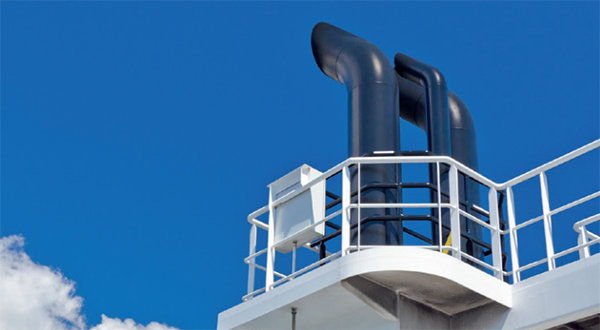Ole-Johan Øby Svendsen, Sales Manager, Wärtsilä Exhaust Gas Cleaning, presented means of meeting SOx emission compliance, including alternative technology at the 2017 GREEN4SEA Conference. Mr. Svendsen referred to his company portfolio which includes inline and venturi type scrubbers, system configurations including open loop, closed loop and hybrid systems. He also presented a case study of OPEX, CAPEX and payback time for open loop, closed loop and hybrid as well as some selected reference projects along with the main figures of the reference list.
The easiest and most convenient alternative for SOx Emission Compliance is to change fuels. It has a relatively small investment cost, however, a very big impact in operating costs. Another solution which can also reduce NOx and Particulates is the LNG conversion. In this case the investment costs huge. Furthermore, for vessels that are trading long routes, fuel tanks need to be huge which further impacts the cost. However, this alternative has some good use for small vessels that trade in fixed routes where they know that LNG is widely available. It has to be evaluated for a case-case scenario and as a rule of thumb probably it is not the best option for larger vessels that trade longer routes. The third option is using scrubbers which allow you to operate the vessel basically as you did before without an abatement system; you can optimize the scrubber solution to the way you want to operate the vessel. It has a low lifecycle cost but on the downside the investment is subject to the price difference between compliant fuel and HFO.
Wartsila can customize a scrubber solution according to each ship’s needs. Specifically, there are a lot of different options and there is always an option to tailor-make the system for each vessel. Thus, there are the Inline and venturi type scrubbers as well as system configurations including hybrid systems; open loop and close loop systems as well. The pictures below depict the company’s scrubber portfolio.


Moreover, further customization can be done as there are special concepts for special vessels; Cruise Concept; Ferry Concept; VLCC Concept which is concepts where we have investigated what is applicable for the different types of vessels. Also there are a number of options that the operators can customize the system which can have the options below:
- Redundancy for added reliability
- Extraction fan for eliminating scrubber back pressure
- Booster fan for boilers
- Open loop water cleaning
- Sludge de-watering system
- Booster pump and specialized venturi for added PM removal
- 2020 solution
- Open loop VGP
A scrubber EGR system has also been developed and is currently being tested on a vessel where it will be able to reach Tier III having a scrubber and EGR combined. In essence with the scrubber system it is possible to catch Sulphur, Particulates and reduce NOx.
For a lot of ship owners, the return of investment is the most important factor when deciding to install a scrubber system. Thus, a case study of OPEX, CAPEX and payback time for open loop, closed loop and hybrid systems on a 70.000 DWT Product Tanker can analyze the issue thoroughly in a careful approach. This vessel has a total engine power of 11 MW,and the case study is applicable for any kind of vessel with similar power output.
A price delta of HFO/MGO of 220 $/t has been set and fuel of 2.5% S HFO has been chosen for it as this is close to the world average. Its SFOC is about 190 g/kWh and operational period is a bit high, 360 days a year. Regarding the vessels operational profile, for seagoing operations it has 70% MCR average power and duration of 252 days, while for manoeuvring and port operations it has 25% MCR average power and duration of 108 days.

In the chart above, in terms of the OPEX comparison, it is clear that the open loop system is the best option in terms of annual savings as it doesn’t consume caustic soda, while the closed-loop option comes out worst as it consumed the most caustic soda.

If we take the total CAPEX of both the system price and the installation cost we will have a payback time of 1,5 years approximately for an open loop; close loop will have a bit more than 3 years and hybrid will have a payback time of a bit more than 2 years. In essence all of them are fairly good.
Three reference projects of the company are: the Harmony of the Seas which the biggest cruise vessel with the biggest scrubber system, Clipper Quito & Clipper Posh which is the first VLGC with a scrubber system and the Wilhemsen-Thalatta which is the third scrubber installation out of five for Wilhemsen. In total, Wartsila has so far completed 93 installations of 190 scrubbers with more than 2600 MW between them.
Above text is an edited article of Ole-Johan Øby Svendsen’s presentation during 2017 GREEN4SEA Conference & Awards
You may view his presentation video by clicking here
| Click here to view all the presentations of 2017 GREEN4SEA Conference & Awards |
The views presented hereabove are only those of the author and not necessarily those of GREEN4SEA and are for information sharing and discussion purposes only.
[divider]
Ole-Johan Øby Svendsen, Sales Manager, Wärtsilä Exhaust Gas Cleaning

Ole-Johan Øby Svendsen is Sales Manager of Wärtsilä Exhaust Gas Cleaning with responsibility for the Korean and Chinese market, as well as Greece, Turkey and Singapore. He is experienced in both new build and retrofit projects.





























































